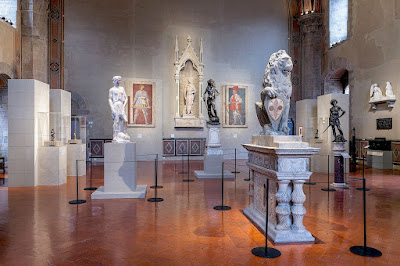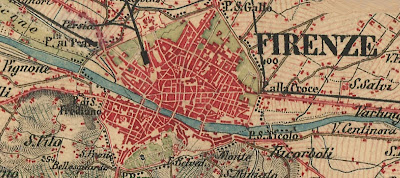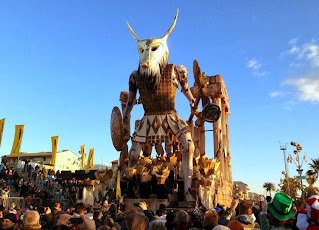As my faithful readers will remember, I am an enthusiast for the
formal gardens of Tuscany, especially those of the larger
villas of Tuscany. I therefore always look forward to
Open gardens day in Florence (
Cortili e Giardini Aperti a Firenze) which
in 2022, takes place on 22 May, when the private gardens of Florence are open to the public -
see the list here. In 2018, I took the opportunity to visit some gardens in the Oltrarno which I either hadn't seen before at all or only a long time ago.
The one I want to describe in some detail is the Giardino San Francesco di Paola which extends upwards and away from the former home of
Harry Brewster, "the last of the cosmopolites of Florence". Brewster, a descendent of William Brewster of the Mayflower, was also the grandson, on his mother's side, of the German sculptor Adolf von Hildebrandt, whose studio occupied part of the former Minimite convent of San Francesco di Paola. The convent is located at the foot of Bellosguardo, the beautiful hill that dominates the Oltrarno. It was an evocative experience for me to walk up Via Villani to the circular Piazza San Francesco di Paola. Although there are 19 C and modern buildings on two sides of the piazza, the old church and the wall and gate of the convent are still there, just as described by Brewster.
The main structure was long ago divided up into apartments and, alas, the building is looking much the worse for wear. Indeed, so are some of the remaining Hildebrandt sculptures standing in the loggia at the back of the villa.
 |
| The loggia of the Villa of San Francesco di Paola - much in need of some restoration |
However, the garden is beautifully kept up, as is the hay shed (fienile) which Brewster converted into a neat, strangely English-looking, cottage covered in roses and surrounded by a small lawn, where he himself lived in frugal simplicity writing his books. One continues up a series of irregular steps to Brewster's beloved belvedere from which there is a beautiful view of Florence, which because of its lower altitude, is almost more beautiful than the vista from the top of Bellosguardo.
 |
| View of Florence from the belvedere in the Giardino San Francesco di Paola |
Next I walked to entrance of the Giardini Torrigiani not far from the Pitti palace. I have often passed the fine iron gates of these gardens - little did I know that there are 17 acres of gardens hidden behind the walls in the centre of the Oltrarno. In fact, the Torrigiani gardens are the largest private gardens within city limits in all Europe.
 |
| A view of a small part of the Torrigiani Gardens, In Florence |
The Torrigiani gardens were originally planted by the founder of the Italian Botanical Society, the oldest such society, and the garden still has an uncommonly wide variety of trees, especially exotic species, in keeping with its 19 C “English Landscape” style. The gardens were designed at the height of the Romantic movement in the early 19 C, forming an idyllic oasis of green around the original 16 C villa. The garden hosts rare tree species, wide English-style lawns, herb and vegetables gardens, sculpted lions, a beautifully restored greenhouse and remains of the city walls built under Cosimo I in 1544. The layout of the garden is also profoundly symbolic and I strongly advise visiting it with a good Tuscan garden guide book in hand.
 |
| The astronomical tower in the Torrigiani gardens |
Last but not least, I visited that exquisite jewel of a garden, the Giardino Corsi Annalena, nearby on via Romana. This garden is located on land formerly owned by the monastery of San Vincenzo which was founded in around 1441 by Countess Anna Elena (Annalena) Malatesta. During the long struggle for supremacy between Florence and Sienna, the area was dominated by the fortifications created by Cosimo I de’ Medici, including an underground passage that until this day connects the Boboli, Corsi and Torrigiani gardens. Following the destruction of the fortifications in 1571, the area was left abandoned for many years. In 1790, the Marquis Tommaso Corsi purchased the land, then known as the "Moors’ Garden", and the architect Giuseppe Manetti designed what can be considered the first English garden in Florence. It was completed during the years 1801 to 1810. If you have the chance to visit this beautiful garden, please don't miss it.
 |
| The Giardino Corsi Annalena in Florence |
 |
Don't forget to visit my Tuscany
Travel Guide!
Up-to-date news on what to see and where to stay in Chianti and all of Tuscany.
Tuscany Travel Guide
|
|
Author: Anna Maria Baldini






















